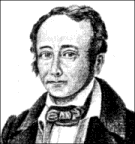|
The heats of reaction also add in the same way. In general, if we
can add or subtract two reactions to obtain a third, then the heat
of this third reaction is obtained by adding or subtracting the heats
of the first two. For those who particularly enjoy filing things away
by name, this is Hess' law of heat summation. It actually is a natural
consequence of the first law
of thermodynamics.
(In the example above, the reaction of hydrogen
and oxygen gases to produce water vapor, followed by condensation
of the vapor in a second step, must lead to exactly the same enthalpy
change as the reaction of hydrogen and oxygen gases to produce liquid
water directly. Hence the heats of the first two reactions must add
to yield the heat of the direct process.)
We must be careful that the two reactions added really do yield the
third, and that the heats used are for the reactions as they are written.
For example, we could multiply the hydrogen combustion reaction by
two to eliminate the fractional coefficient before the oxygen, but
then the heat of reaction also would have to be doubled:
2H2(g)
+ 02(g) �
2H20(g) DH=-116
kcal
|

|
|
